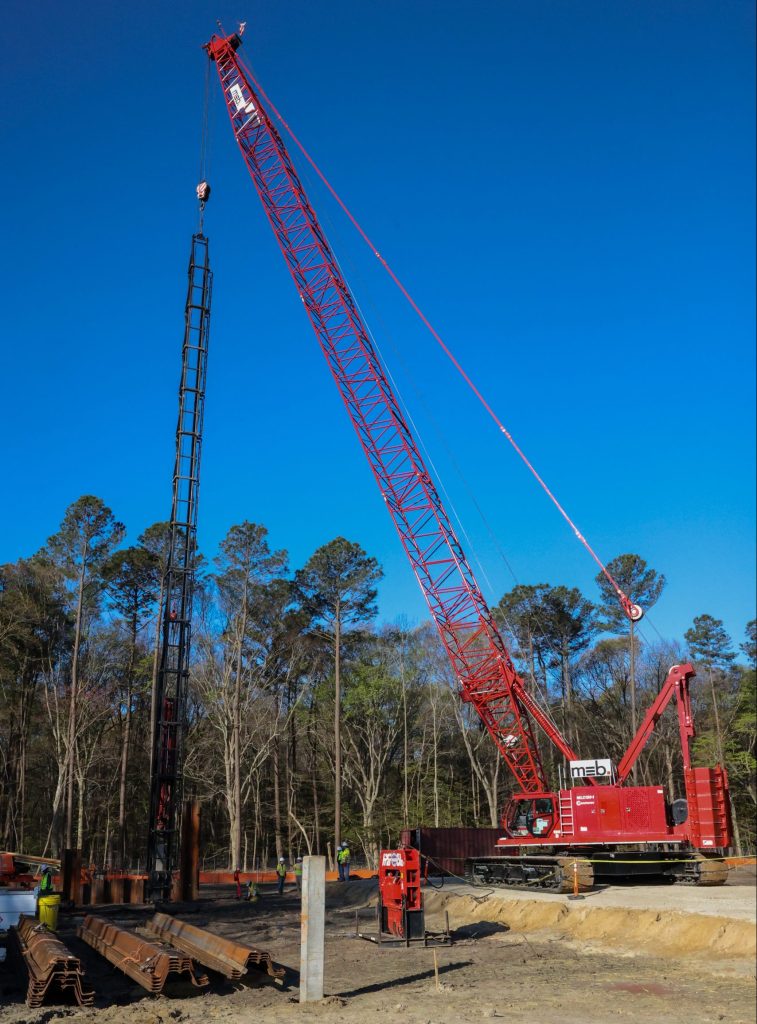Work is underway at the Tabb Pressure Reducing Station and Offline Storage Facility project for Hampton Roads Sanitation District (HRSD) in Yorktown, Virginia.
MEB’s new 150-ton Manitowoc crane was delivered and assembled onsite. The necessary pile-driving equipment was also assembled to drive the 75’ test piles. On this job our team is driving the piles with swinging leads.  This is the less-than-ideal method because the swinging leads are more difficult to manage while driving as opposed to fixed leads which are “fixed” to the crane, resulting in a more rigid and manageable system. The team opted for the swinging leads method so that production piles can be driven at the bottom of the pump well/cofferdam rather than from the existing grade and being cut off after the cofferdam excavation. Saving the project time and wasted material.
This is the less-than-ideal method because the swinging leads are more difficult to manage while driving as opposed to fixed leads which are “fixed” to the crane, resulting in a more rigid and manageable system. The team opted for the swinging leads method so that production piles can be driven at the bottom of the pump well/cofferdam rather than from the existing grade and being cut off after the cofferdam excavation. Saving the project time and wasted material.
THE PROCESS //
After the equipment was delivered and assembled the MEB team drove test piles the first week of April at the engineer’s prescribed depths. These calculated depths are what is needed to provide the capacities required by the structural design. A PDA analysis was conducted while driving to determine whether the pile will meet design capacity.
 Once the test piles are driven, they are to sit for a 7-day period. Then, the team performed a “restrike.” During this, another PDA analysis was performed, and these data points ultimately determined the necessary length of production piles that will meet the design capacity.
Once the test piles are driven, they are to sit for a 7-day period. Then, the team performed a “restrike.” During this, another PDA analysis was performed, and these data points ultimately determined the necessary length of production piles that will meet the design capacity.
Now, we can release the production piles accordingly and continue the process of driving all 244 with our in-house crew. Starting with 160 piles supporting the 2.5 million gallon Offline Storage Tank. Then crews will switch their focus to the Pressure Reducing Station (PRS). Prior to driving the 84 production piles for the PRS, MEB must install the cofferdam excavation support system entirely, which includes:
-
- MEB to drive 150 pairs of sheet piles to form the encompassing cofferdam
- The site subcontractor to excavate the required relief cut around the cofferdam – the relief cut assists in relieving pressure against the sheets
- MEB to install the required wellpoint system to draw water down against the sheets, reducing the hydrostatic pressure against the sheets
- The site subcontractor must excavate to the bottom of the cofferdam/pump well
Once that is all completed, MEB can then start driving the PRS production piles at the bottom of the cofferdam via the swinging leads. The work associated with driving sheets and concrete piles will all be performed by MEB’s in-house team. Then MEB concrete crews can begin the concrete slabs and walls.
We take pride in having a robust workforce and the equipment that allows us to self-perform various types of work, giving us more control of the budget and schedule.
Project Team:
Tim Griffin – Vice President – Environment/Civil
Brandon Jones – Project Manager
John Riggins – Senior Project Engineer
Gary Culpepper – Superintendent
Michelle Cleavenger – Administrative Assistant
Adam Florian – Crane Operator/Superintendent
Jessie Jones – Assistant Superintendent
Morgan Bender – Pile Driver
Dalton Moore – Laborer




